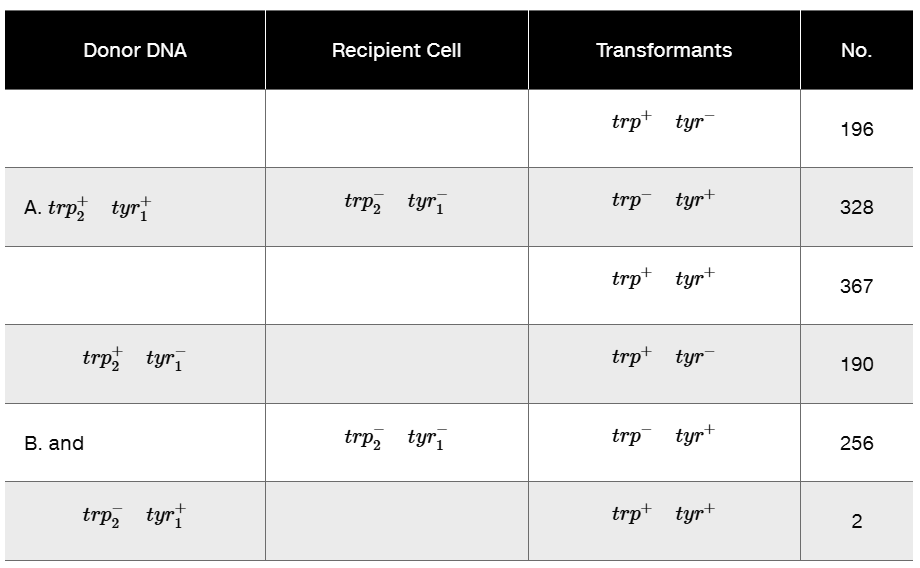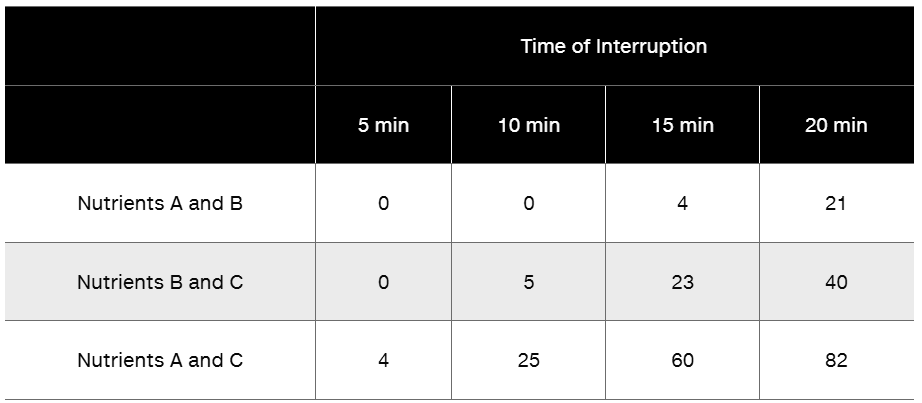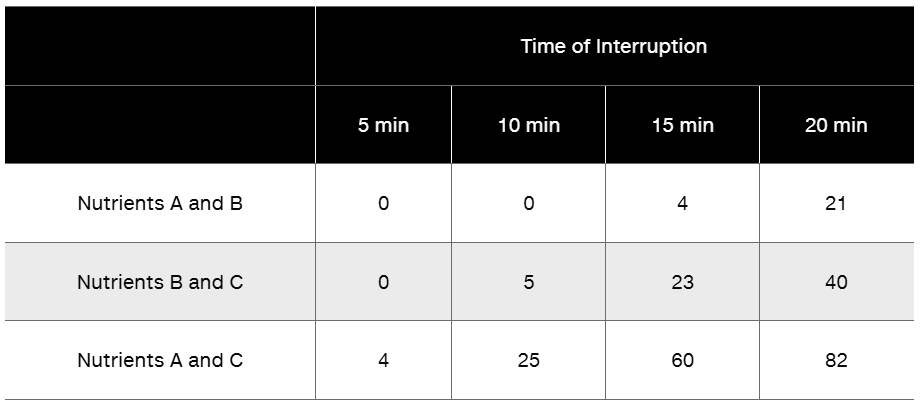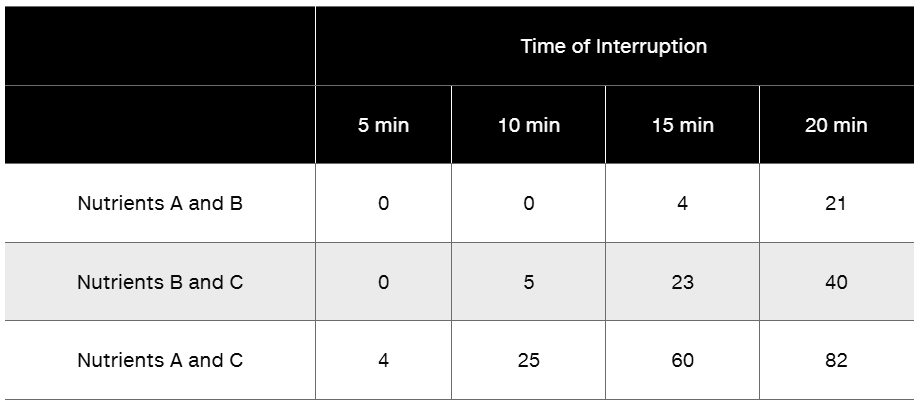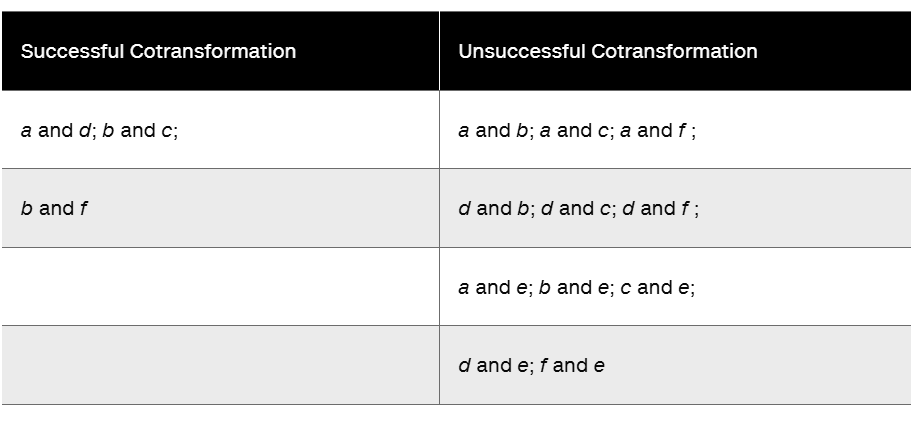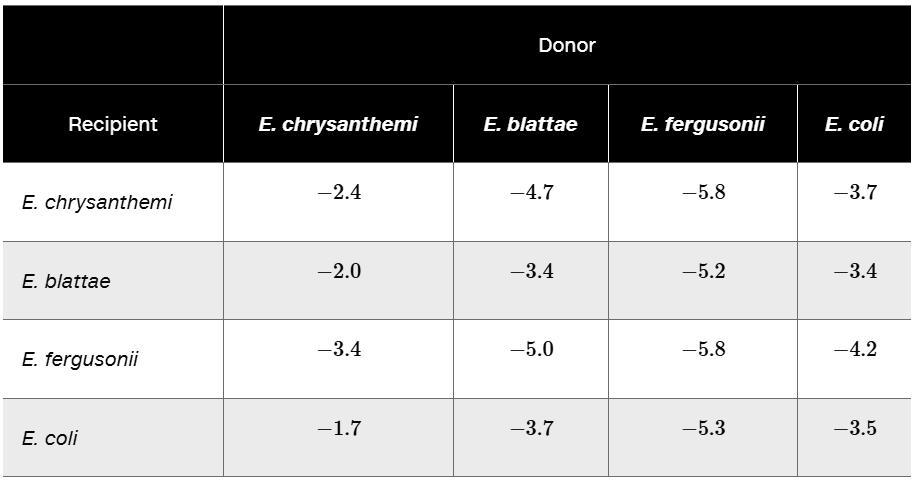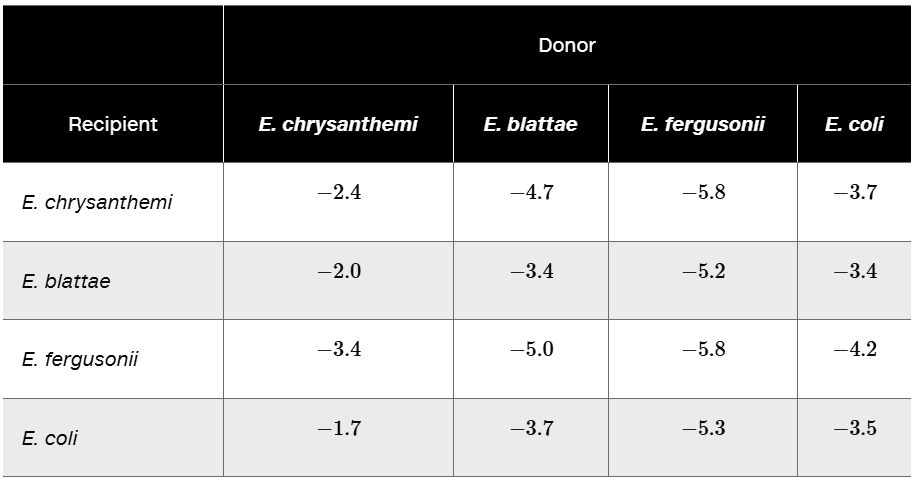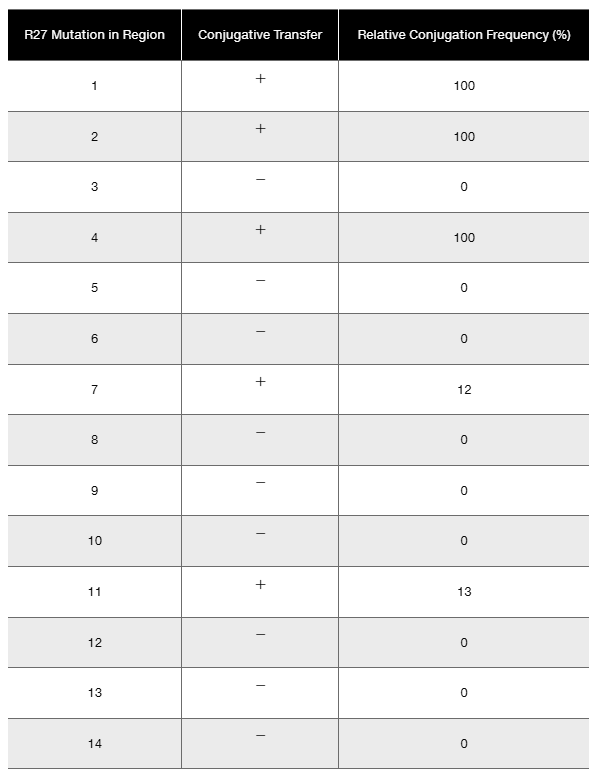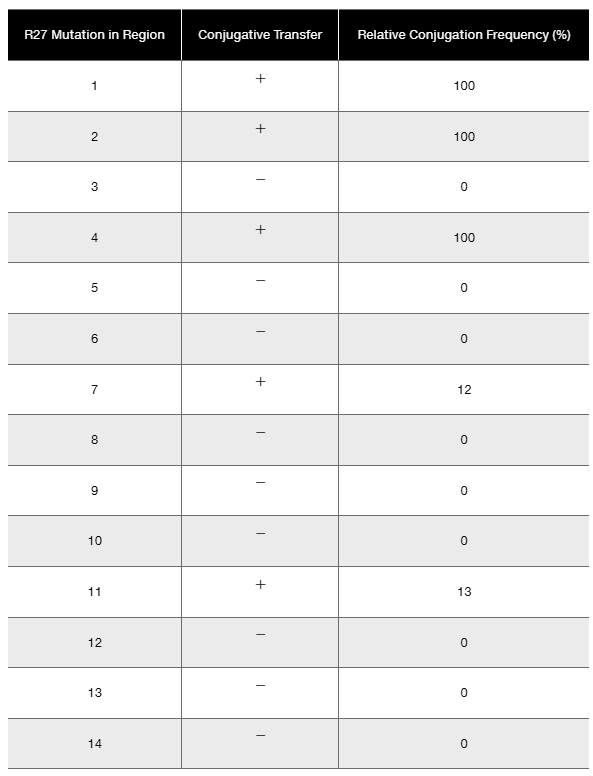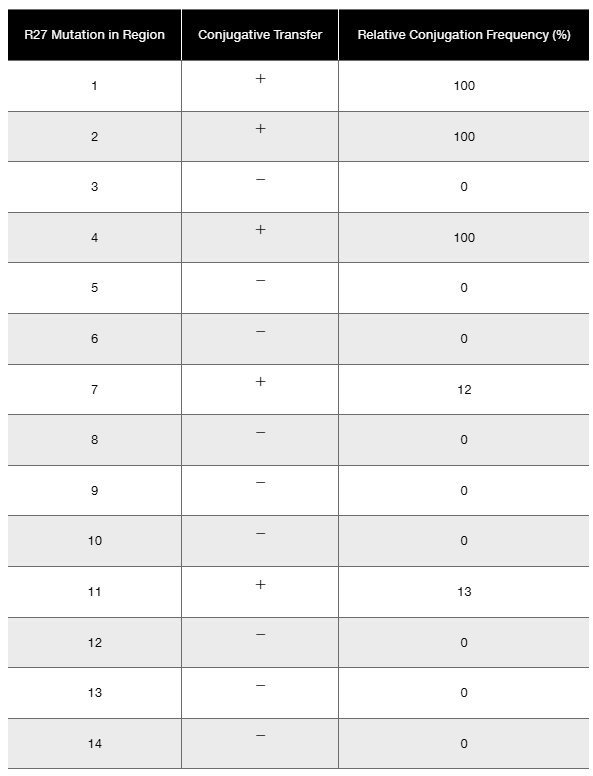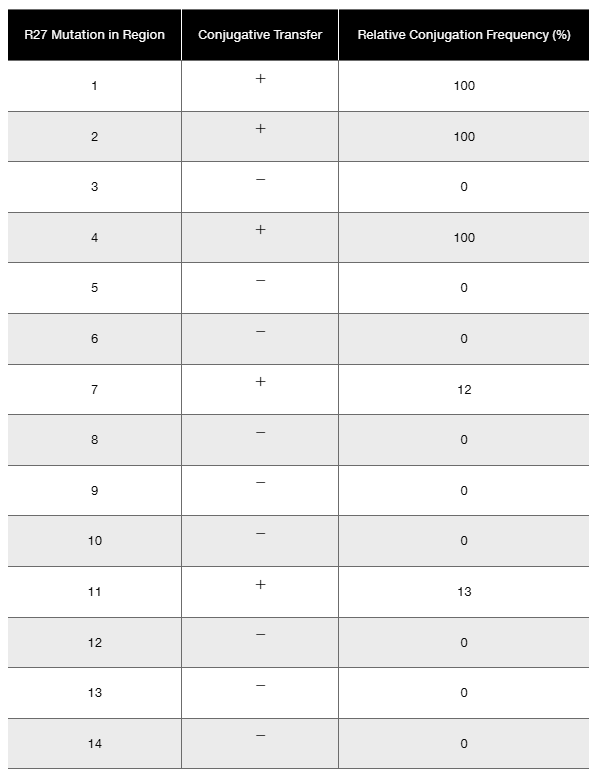 Back
BackProblem 22a
In studies of recombination between mutants 1 and 2 from Problem 21, the results shown in the following table were obtained.
Calculate the recombination frequency.
Problem 22c
In studies of recombination between mutants 1 and 2 from Problem 21, the results shown in the following table were obtained.
When mutant 6 was tested for recombination with mutant 1, the data were the same as those shown above for strain B, but not for K12. The researcher lost the K12 data but remembered that recombination was ten times more frequent than when mutants 1 and 2 were tested. What were the lost values (dilution and plaque numbers)?
Problem 23
In Bacillus subtilis, linkage analysis of two mutant genes affecting the synthesis of two amino acids, tryptophan (trp₂⁻) and tyrosine (trp₁⁻), was performed using transformation. Examine the following data and draw all possible conclusions regarding linkage. What is the purpose of Part B of the experiment? [Reference: E. Nester, M. Schafer, and J. Lederberg (1963).]
Problem 24a
An Hfr strain is used to map three genes in an interrupted mating experiment. The cross is Hfr/a⁺b⁺c⁺ rif x F⁻/a⁻b⁻c⁻ rifT (No map order is implied in the listing of the alleles; rifT is resistance to the antibiotic rifampicin.) The a⁺ gene is required for the biosynthesis of nutrient A, the b⁺ gene for nutrient B, and the c⁺ gene for nutrient C. The minus alleles are auxotrophs for these nutrients. The cross is initiated at time = 0, and at various times, the mating mixture is plated on three types of medium. Each plate contains minimal medium (MM) plus rifampicin plus specific supplements that are indicated in the following table. (The results for each time interval are shown as the number of colonies growing on each plate.)
What is the purpose of rifampicin in the experiment?
Problem 24b
An Hfr strain is used to map three genes in an interrupted mating experiment. The cross is Hfr/a⁺b⁺c⁺ rif x F⁻/a⁻b⁻c⁻ rifT (No map order is implied in the listing of the alleles; rifT is resistance to the antibiotic rifampicin.) The a⁺ gene is required for the biosynthesis of nutrient A, the b⁺ gene for nutrient B, and the c⁺ gene for nutrient C. The minus alleles are auxotrophs for these nutrients. The cross is initiated at time = 0, and at various times, the mating mixture is plated on three types of medium. Each plate contains minimal medium (MM) plus rifampicin plus specific supplements that are indicated in the following table. (The results for each time interval are shown as the number of colonies growing on each plate.)
Based on these data, determine the approximate location on the chromosome of the a, b, and c genes relative to one another and to the F factor.
Problem 24c
An Hfr strain is used to map three genes in an interrupted mating experiment. The cross is Hfr/a⁺b⁺c⁺ rif x F⁻/a⁻b⁻c⁻ rifT (No map order is implied in the listing of the alleles; rifT is resistance to the antibiotic rifampicin.) The a⁺ gene is required for the biosynthesis of nutrient A, the b⁺ gene for nutrient B, and the c⁺ gene for nutrient C. The minus alleles are auxotrophs for these nutrients. The cross is initiated at time = 0, and at various times, the mating mixture is plated on three types of medium. Each plate contains minimal medium (MM) plus rifampicin plus specific supplements that are indicated in the following table. (The results for each time interval are shown as the number of colonies growing on each plate.)
Can the location of the rif gene be determined in this experiment? If not, design an experiment to determine the location of rif relative to the F factor and to gene b.
Problem 25
A plaque assay is performed beginning with 1 mL of a solution containing bacteriophages. This solution is serially diluted three times by combining 0.1 mL of each sequential dilution with 9.9 mL of liquid medium. Then 0.1 mL of the final dilution is plated in the plaque assay and yields 17 plaques. What is the initial density of bacteriophages in the original 1 mL?
Problem 26
In a cotransformation experiment, using various combinations of genes two at a time, the following data were produced. Determine which genes are 'linked' to which others.
Problem 27
For the experiment in Problem 26, another gene, g, was studied. It demonstrated positive cotransformation when tested with gene f. Predict the results of testing gene g with genes a, b, c, d, and e.
Problem 28a
Bacterial conjugation, mediated mainly by conjugative plasmids such as F, represents a potential health threat through the sharing of genes for pathogenicity or antibiotic resistance. Given that more than 400 different species of bacteria coinhabit a healthy human gut and more than 200 coinhabit human skin, Francisco Dionisio [(2002) Genetics 162:1525 1532] investigated the ability of plasmids to undergo between-species conjugal transfer. The following data are presented for various species of the enterobacterial genus Escherichia. The data are presented as 'log base 10' values; for example, -2.0 would be equivalent to 10⁻² as a rate of transfer. Assume that all differences between values presented are statistically significant.
What general conclusion(s) can be drawn from these data?
Problem 28b
Bacterial conjugation, mediated mainly by conjugative plasmids such as F, represents a potential health threat through the sharing of genes for pathogenicity or antibiotic resistance. Given that more than 400 different species of bacteria coinhabit a healthy human gut and more than 200 coinhabit human skin, Francisco Dionisio [(2002) Genetics 162:1525 1532] investigated the ability of plasmids to undergo between-species conjugal transfer. The following data are presented for various species of the enterobacterial genus Escherichia. The data are presented as 'log base 10' values; for example, -2.0 would be equivalent to 10⁻² as a rate of transfer. Assume that all differences between values presented are statistically significant.
In what species is within-species transfer most likely? In what species pair is between-species transfer most likely?
Problem 28c
Bacterial conjugation, mediated mainly by conjugative plasmids such as F, represents a potential health threat through the sharing of genes for pathogenicity or antibiotic resistance. Given that more than 400 different species of bacteria coinhabit a healthy human gut and more than 200 coinhabit human skin, Francisco Dionisio [(2002) Genetics 162:1525 1532] investigated the ability of plasmids to undergo between-species conjugal transfer. The following data are presented for various species of the enterobacterial genus Escherichia. The data are presented as 'log base 10' values; for example, -2.0 would be equivalent to 10⁻² as a rate of transfer. Assume that all differences between values presented are statistically significant.
What is the significance of these findings in terms of human health?
Problem 29a
A study was conducted in an attempt to determine which functional regions of a particular conjugative transfer gene (tra1) are involved in the transfer of plasmid R27 in Salmonella enterica. The R27 plasmid is of significant clinical interest because it is capable of encoding multiple-antibiotic resistance to typhoid fever. To identify functional regions responsible for conjugal transfer, an analysis was conducted by Lawley et al. (2002). J. Bacteriol. 184:2173-2180 was conducted in which particular regions of the tra1 gene were mutated and tested for their impact on conjugation. Shown here is a map of the regions tested and believed to be involved in conjugative transfer of the plasmid. Similar coloring indicates related function. Numbers correspond to each functional region subjected to mutation analysis.
Accompanying the map is a table showing the effects of these mutations on R27 conjugation.
Effects of Mutations in Functional Regions of Transfer Region 1 (tra1) on R27 Conjugation
Given the data, do all functional regions appear to influence conjugative transfer?
Problem 29b
A study was conducted in an attempt to determine which functional regions of a particular conjugative transfer gene (tra1) are involved in the transfer of plasmid R27 in Salmonella enterica. The R27 plasmid is of significant clinical interest because it is capable of encoding multiple-antibiotic resistance to typhoid fever. To identify functional regions responsible for conjugal transfer, an analysis was conducted by Lawley et al. (2002). J. Bacteriol. 184:2173-2180 was conducted in which particular regions of the tra1 gene were mutated and tested for their impact on conjugation. Shown here is a map of the regions tested and believed to be involved in conjugative transfer of the plasmid. Similar coloring indicates related function. Numbers correspond to each functional region subjected to mutation analysis.
Accompanying the map is a table showing the effects of these mutations on R27 conjugation.
Effects of Mutations in Functional Regions of Transfer Region 1 (tra1) on R27 Conjugation
Which regions appear to have the most impact on conjugation?
Problem 29c
A study was conducted in an attempt to determine which functional regions of a particular conjugative transfer gene (tra1) are involved in the transfer of plasmid R27 in Salmonella enterica. The R27 plasmid is of significant clinical interest because it is capable of encoding multiple-antibiotic resistance to typhoid fever. To identify functional regions responsible for conjugal transfer, an analysis was conducted by Lawley et al. (2002). J. Bacteriol. 184:2173-2180 was conducted in which particular regions of the tra1 gene were mutated and tested for their impact on conjugation. Shown here is a map of the regions tested and believed to be involved in conjugative transfer of the plasmid. Similar coloring indicates related function. Numbers correspond to each functional region subjected to mutation analysis.
Accompanying the map is a table showing the effects of these mutations on R27 conjugation.
Effects of Mutations in Functional Regions of Transfer Region 1 (tra1) on R27 Conjugation
Which regions appear to have a limited impact on conjugation?
Problem 29d
A study was conducted in an attempt to determine which functional regions of a particular conjugative transfer gene (tra1) are involved in the transfer of plasmid R27 in Salmonella enterica. The R27 plasmid is of significant clinical interest because it is capable of encoding multiple-antibiotic resistance to typhoid fever. To identify functional regions responsible for conjugal transfer, an analysis was conducted by Lawley et al. (2002). J. Bacteriol. 184:2173-2180] was conducted in which particular regions of the tra1 gene were mutated and tested for their impact on conjugation. Shown here is a map of the regions tested and believed to be involved in conjugative transfer of the plasmid. Similar coloring indicates related function. Numbers correspond to each functional region subjected to mutation analysis.
Accompanying the map is a table showing the effects of these mutations on R27 conjugation.
Effects of Mutations in Functional Regions of Transfer Region 1 (tra1) on R27 Conjugation
What general conclusions might one draw from these data?



